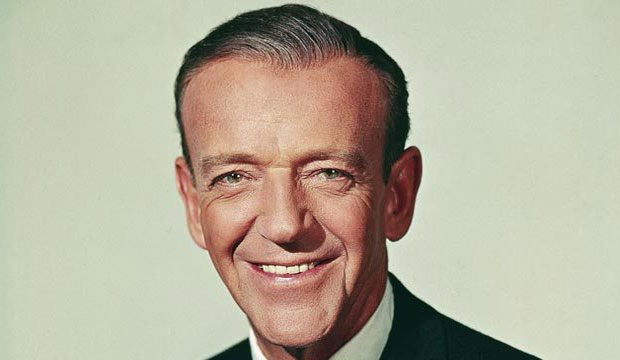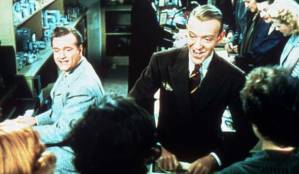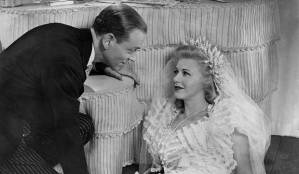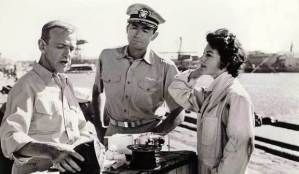
Fred Astaire was an Oscar-nominated song and dance man best remembered for a series of musicals he made alongside many female dancer, but especially Ginger Rogers (who, as she famously said, did everything he did, only backwards and in heels). Yet his filmography extends well past those titles. Let’s take a look back at 20 of his greatest films, ranked worst to best.
As a dancer, Astaire was known for his perfectionism, doing multiple takes to get the most precise movements correct. His immaculate steps were matched only by his outfits, which often consisted of top hats and coats.
After making a name for himself on the stage in London and on Broadway, Astaire came to Hollywood. He first appeared with fellow dancer Rogers in “Flying Down to Rio” (1933), where they played second fiddle to Dolores del Rio and Gene Raymond. Their first starring vehicle came just one year later: “The Gay Divorcee” (1934).
Their subsequent films, including “Top Hat” (1935), “Follow the Fleet” (1936), “Swing Time” (1936), and “Shall We Dance” (1937), all more or less followed the same formula: Fred meets Ginger and convinces her to love him through dance. Then there’s a series of misunderstandings, mistaken identities, and plot contrivances that keep them apart, before a final musical number brings them back together. Marked by their endless wit, glamour, and catchy tunes by the likes of Irving Berlin, George Gershwin and Ira Gershwin, Jerome Kern and Dorothy Fields, the films delighted Depression-era audiences in their heyday and inspired future generations of hoofers.
As Astaire grew older, he focused more on dramatic acting, earning a Golden Globe nomination for his supporting turn in Stanley Kramer‘s nuclear war drama “On the Beach” (1959). He reaped his sole Oscar nomination as Best Supporting Actor for the disaster flick “The Towering Inferno” (1974), which brought him victories at the Globes and BAFTA.
Astaire won an additional Globe as Best Comedy/Musical Actor for “Three Little Words” (1950), competing again for “The Pleasure of His Company” (1961) and “Finian’s Rainbow” (1968). He received an Honorary Oscar in 1950, the Cecil B. DeMille prize in 1961 and the Kennedy Center Honors in 1978.
On the TV side, Astaire won Emmys for the specials “An Evening with Fred Astaire” in 1959 and “Astaire Time” in 1961, and the television movie “A Family Upside Down” in 1978.
Tour our photo gallery of Astaire’s 20 greatest films, including the titles mentioned above as well as “Holiday Inn” (1942), “The Band Wagon” (1953), “Funny Face” (1957) and more.
-
20. THE BARKLEYS OF BROADWAY (1949)

Image Credit: Mgm/Kobal/REX/Shutterstock Directed by Charles Walters. Written by Betty Comden and Adolph Green. Starring Fred Astaire, Ginger Rogers, Oscar Levant, Billie Burke, Gale Robbins, Jacques Francois.
“The Barkleys of Broadway” was the last onscreen pairing of Astaire and Ginger Rogers, who served as a last minute replacement for Judy Garland. (The two had not appeared together in a movie since 1939’s “The Story of Irene and Vernon Castle.”) It was also the only film they made together in color, which takes away some of the magic and mystery in a weird way. Yet the chemistry remains in this charming story about a husband and wife dance team who break up when the wife becomes a serious actress (which oddly mirrored their own careers; Rogers left the duo to focus on a dramatic acting career, winning the Oscar as Best Actress for “Kitty Foyle” in 1940). Ginger and Fred dance to “They Can’t Take That Away From Me,” which Fred sang in their previous outing, “Shall We Dance.”
-
19. THE STORY OF VERNON AND IRENE CASTLE (1939)

Image Credit: Rko/Kobal/REX/Shutterstock Directed by H. C. Potter. Screenplay by Richard Sherman, adaptation by Oscar Hammerstein II and Dorothy Yost, story by Irene Castle. Starring Fred Astaire, Ginger Rogers, Edna May Oliver, Walter Brennan, Lew Fields, Etienne Girardot, Janet Beecher.
This biographical musical was the last film Astaire made with Ginger Rogers until “The Barkleys of Broadway” 10 years later, and while it fails to capture the magic of their earlier outings, it’s entertaining nonetheless. Fred and Ginger star as Vernon and Irene Castle, who rose to fame and fortune as ballroom dancers in the years leading up to WWI. When Vernon is drafted into service as a pilot, he’s killed in a training accident, and he and Irene share one last waltz on his way to the afterlife. The real Irene Castle, who served as a technical consultant, disowned the movie for its many inaccuracies, from Rogers’s prudish costumes to the casting of Walter Brennan as her longtime servant, who was actually black.
-
18. THREE LITTLE WORDS (1950)

Image Credit: Snap/REX/Shutterstock Directed by Richard Thorpe. Written by George Wells. Starring Fred Astaire, Red Skelton, Vera-Ellen, Arlene Dahl.
“Three Little Words” is your run-of-the-mill musical biopic, charting the ups-and-downs of songwriting duo Bert Kalmar (Astaire) and Harry Ruby (Red Skelton). All the beats are hit, from their failed beginnings in other careers — Kalmar a fumbling magician, Ruby an unskilled baseball player — to their penning of their classic songs, to their contrived third act breakup and reunion. But the musical numbers, including “Where Did You Get That Girl?,” “Who’s Sorry Now,” and the title song, are a treat. The film brought Astaire a Golden Globe win as Best Comedy/Musical Actor, though he was snubbed at the Oscars. Debbie Reynolds appears in an early role as singer Helen Kane (who actually dubbed her own singing voice, despite Reynolds’s own vocal talents).
-
17. YOU WERE NEVER LOVELIER (1942)

Image Credit: Columbia/Kobal/REX/Shutterstock Directed by William A. Seiter. Screenplay by Michael Fessier, Ernest Pagano, and Delmer Daves, story by Carlos A. Olivari and Sixto Pondal Rios. Starring Fred Astaire, Rita Hayworth, Adolph Menjou, Isobel Elsom, Leslie Brooks, Adele Mara, Xavier Cugat.
Astaire paired up with red-headed bombshell Rita Hayworth for this lighthearted musical about the love that can grow from deception. “You Were Never Lovelier” centers on an American dancer (Astaire) who frequently loses money on horse races. Broke in Bueno Aires, he’s hired by a wealthy nightclub owner (Adolph Menjou) to perform on the condition he pretends to be a suitor sending love letters to his daughter (Hayworth), who he’s hoping to marry off. Though he’s skeptical at first, Astaire soon finds himself actually falling for her (and honestly, how couldn’t he?). The film earned three Oscar nominations, including for the song “Dearly Beloved” by Jerome Kern and Johnny Mercer.
-
16. CAREFREE (1938)

Image Credit: Rko/Kobal/REX/Shutterstock Directed by Mark Sandrich. Screenplay by Allan Scott and Ernest Pagano, story and adaptation by Dudley Nichols and Hagar Wilde, original idea by Marian Ainslee and Guy Endore. Starring Fred Astaire, Ginger Rogers, Ralph Bellamy, Luella Gear, Jack Carson, Clarence Kolb, Franklin Pangborn.
Unique among Astaire-Rogers collaborations, “Carefree” is better remembered for its screwball comedy than its dance numbers. That’s not to say there aren’t some spectacular ones, with songs courtesy of Irving Berlin (including the Oscar-nominated “Change Partners and Dance with Me”). Rogers stars as an indecisive woman whose boyfriend (Ralph Bellamy) takes her to a psychiatrist (Astaire), who agrees to use hypnosis in order to convince her to marry him. Instead, she ends up falling in love with the doctor. Though slapstick wasn’t exactly their strong suit, Ginger and Fred nevertheless are endlessly charming as always.
-
15. THE PLEASURE OF HIS COMPANY (1961)

Image Credit: Moviestore/REX/Shutterstock Directed by George Seaton. Screenplay by Samuel A. Taylor, based on the play by Taylor and Cornelia Otis Skinner. Starring Fred Astaire, Debbie Reynolds, Lilli Parlmer, Tab Hunter, Gary Merrill, Charles Ruggles.
As he got older, Astaire tried to transition into non-singing, non-dancing roles, proving he had the stuff to carry a film without the aid of his tap shoes. One of his better efforts in this vein, “The Pleasure of His Company,” casts him as a long-absent father who returns home to see his daughter (Debbie Reynolds) get married to a cattle rancher (Tab Hunter). The charming, worldly nomad soon realizes he’s got to make up for lost time with his child and ex-wife (Lilli Palmer). The role brought Astaire a Golden Globe nomination as Best Comedy/Musical Actor, though the Academy overlooked him.
-
14. SILK STOCKINGS (1957)

Image Credit: Mgm/Kobal/REX/Shutterstock Directed by Rouben Mamoulian. Screenplay by Leonard Gershe and Leonard Spigelgass, based on the play by George S. Kaufman, Leueen MacGrath, and Abe Burrows and the novel ‘Ninotchka’ by Melchior Lengyel. Starring Fred Astaire, Cyd Charisse, Janis Paige, Peter Lorre, Jules Munshin, Joseph Buloff, George Tobias, Wim Sonneveld.
Greta Garbo’s “Ninotchka” gets the musical treatment, first on the stage, then on the screen. “Silk Stockings” starts with three bumbling Soviet spies (Peter Lorre, Jules Munshin, Joseph Buloff) failing to retrieve a defecting Russian composer (Wim Sonneveld) from Paris, where he’s working for an American movie producer (Astaire). The Ministry of Moscow sends the beautiful, humorless Ninotchka (Cyd Charisse) to reclaim all four, but she soon finds her icy exterior being melted by the charming Astaire. The Cole Porter score includes such hits as “Stereophonic Sound,” “All of You,” and “Satin and Silk.”
-
13. FINIAN’S RAINBOW (1968)

Image Credit: Moviestore/REX/Shutterstock Directed by Francis Ford Coppola. Screenplay by E. Y. Harburg and Fred Saidy, based on their stage musical. Starring Fred Astaire, Petula Clark, Don Francks, Keenan Wynn, Al Freeman, Jr., Barbara Hancock, Tommy Steele.
By the time “Finian’s Rainbow” came along, Astaire had not appeared in a movie musical since “Silk Stockings” (1957) 11 years earlier. At 69-years-old, he proved he could still hoof it with the best of them. Directed by a pre-“Godfather” Francis Ford Coppola, this Broadway adaptation centers on an Irish immigrant (Astaire) who moves to the American South with his daughter (Petula Clark) and a pot of gold he stole from the leprechaun Og (Tommy Steele). He believes if he buries it in the ground, it will multiply, but Og has other plans. While there, they try to help a black farmer (Don Francks) who’s being harassed by a racist judge (Keenan Wynn). Astaire earned a Golden Globe bid as Best Comedy/Musical Actor, but was snubbed at the Oscars.
-
12. ROYAL WEDDING (1951)

Image Credit: Robert Quirk/Mgm/Kobal/REX/Shutterstock Directed by Stanley Donen. Story and screenplay by Alan Jay Lerner. Starring Fred Astaire, Jane Powell, Sarah Churchill, Peter Lawford.
“Royal Wedding” was Stanley Donen’s first solo outing as a director, and at just 27-years-old, he proved himself more than capable of handling a complicated Hollywood production. Astaire and Jane Powell star as Tom and Ellen Bowen, a brother-sister dance act who travel to London for a gig at the same time the Royal Wedding is occurring. Their relationship is complicated when each sibling finds romance abroad. As always, Astaire’s nimble footwork is the main attraction (including the stunning “You Are the World to Me” sequence where he dances on the walls and ceiling), and Donen once again displays a unique talent for capturing dance on film. Signature numbers include the Oscar-nominated “Too Late Now” and “Sunday Jumps,” in which Astaire dances with a lamp post.
-
11. SHALL WE DANCE (1937)

Image Credit: Rko/Kobal/REX/Shutterstock Directed by Mark Sandrich. Screenplay by Allan Scott and Ernest Pagano, adaptation by P.J. Wolfson, story by Lee Loeb and Harold Buchman. Starring Fred Astaire, Ginger Rogers, Edward Everett Horton, Eric Blore, Jerome Cowan, Ketti Gallian, William Brisbane, Harriet Hoctor.
Even a lesser Astaire-Rogers outing is first rate entertainment, as proven by this sparkling musical comedy that follows their winning formula to a T. Directed by Mark Sandrich (who helmed many of the duo’s best features), “Shall We Dance” centers on a world renowned ballet dancer (Astaire) who falls in love with a famous tapper (Rogers). After meeting, Rogers’s manager (Jerome Cowan) concocts a phony publicity story claiming the two are married, even though she can’t stand him. They decide to get wed and divorced to squelch the rumor, yet by the end, they’re crazy for each other. As always, the plot is second to the musical numbers, including “Let’s Call the Whole Thing Off,” “They All Laughed,” and the Oscar-nominated “They Can’t Take That Away from Me” from George and Ira Gershwin.
-
10. THE TOWERING INFERNO (1974)

Image Credit: 20th Century Fox/Warners/Kobal/REX/Shutterstock Directed by John Guillermin. Screenplay by Stirling Silliphant, based on the novels ‘The Tower’ by Richard Martin Stern and ‘The Glass Inferno’ by Thomas N. Scortia and Frank M. Robinson. Starring Paul Newman, Steve McQueen, William Holden, Faye Dunaway, Fred Astaire, Susan Blakely, Richard Chamberlain, Jennifer Jones, O. J. Simpson, Robert Vaughn, Robert Wagner.
Astaire earned his sole Oscar nomination for setting his tap shoes aside in this all-star spectacle that represents the zenith of the disaster movies which plagued the box office throughout the 1970s. “The Towering Inferno” casts Paul Newman as an architect whose 135-story skyscraper catches fire on the eve of its opening. He teams up with a gruff fire chief (Steve McQueen) to save the A-listers trapped inside, including Astaire as a con man who flirts with Jennifer Jones. Silly? Absolutely. But it’s also overblown (and at 165 minutes, overlong) fun. The film took home prizes for cinematography, film editing, and the song “We May Never Love Like This Again,” and competed in Best Picture. Astaire won the Golden Globe and BAFTA prizes, but lost at the Academy to Robert De Niro (“The Godfather, Part II”).
-
9. THE GAY DIVORCEE (1934)

Image Credit: Rko/Kobal/REX/Shutterstock Directed by Mark Sandrich. Screenplay by George Marion Jr., Dorothy Yost, Edward Kaufman, based on the musical ‘Gay Divorce’ by Dwight Taylor. Starring Fred Astaire, Ginger Rogers, Alice Brady, Edward Everett Horton, William Austin.
“The Gay Divorcee” was Astaire’s second pairing with Ginger Rogers (following 1933’s “Flying Down to Rio,” where they played second fiddle to Dolores del Rio and Gene Raymond), and the first to feature them as the main attraction. Based on the Broadway musical “Gay Divorce,” it casts Rogers as an American woman who travels to England to legally separate from her husband (William Austin), and while there, she falls in love with a dashing song-and-dance man (Astaire). Musical numbers include Cole Porter’s “Night and Day” and the Oscar-winning “The Continental.” The film earned a Best Picture nomination, though both Ginger and Fred were overlooked. Incidentally, the Production Code forced director Mark Sandrich to change the title because they though the original was too offensive.
-
8. ON THE BEACH (1959)

Image Credit: United Artists/Kobal/REX/Shutterstock Directed by Stanley Kramer. Screenplay by John Paxton, based on the novel by Nevil Shute. Starring Gregory Peck, Ava Gardner, Fred Astaire, Anthony Perkins.
Stanley Kramer’s “On the Beach” feels frighteningly prescient with each passing year, which is troubling considering its subject matter. Based on the novel by Nevil Shute, it imagines a future in which life on the northern hemisphere has been totally wiped out from a nuclear bomb. A group of survivors have gathered in Australia, including Gregory Peck as a submarine commander, Ava Gardner as his girlfriend, Astaire as a scientist, and Anthony Perkins as a naval officer. Though it tends to sermonize in a way that only Kramer can, it benefits from strong performances and striking black-and-white photography. Astaire is particularly good in his first dramatic role. He earned a Golden Globe bid as Best Supporting Actor for the performance, but was snubbed by the Academy.
-
7. FOLLOW THE FLEET (1936)

Image Credit: Snap/REX/Shutterstock Directed by Mark Sandrich. Screenplay by Allan Scott and Dwight Taylor, based on the play ‘Shore Leave’ by Hubert Osborne. Starring Fred Astaire, Ginger Rogers, Harriet Hilliard, Randolph Scott, Astrid Allwyn.
It’s anchors aweigh for Astaire and Rogers in this delightful musical comedy. A reworking of the Hubert Osborne play “Shore Leave,” “Follow the Fleet” casts Astaire and western star Randolph Scott as a pair of Navy sailors on a period of liberty in San Francisco. While on dry land, Astaire tries to rekindle a romance with a dance hall girl (Rogers) and Scott falls in love with her sister (Harriet Hilliard). Contrivances are nothing new for Fred and Ginger pairings, but this one features an almost laughable number of misunderstandings and mistaken identities to drive the plot. No matter, because as always, the main attraction are the dance numbers, including “Let’s Face the Music and Dance,” “We Saw the Sea,” and “Let Yourself Go.”
-
6. HOLIDAY INN (1942)

Image Credit: Moviestore Collection/REX/Shutterstock Directed by Mark Sandrich. Screenplay by Claude Binyon, adaptation by Elmer Rice, based on a story by Irving Berlin. Starring Bing Crosby, Fred Astaire, Marjorie Reynolds, Virginia Dale, Walter Abel.
The plot of “Holiday Inn” is little more than a shoestring to hang a bunch of Irving Berlin-penned musical numbers on, and we wouldn’t have it any other way. It all takes place at a picturesque inn that’s only open on the holidays, where a hoofer (Astaire) and a crooner (Bing Crosby) both fall in love with a rising star (Marjorie Reynolds). That’s about all you need to know, because the enjoyment comes from Astaire’s acrobatics and Crosby’s vocals. The film is best remembered for Berlin’s Oscar-winning tune “White Christmas,” which, as sung by Crosby, became a holiday classic and spawned a loose movie remake of the same name, also starring the singer. In recent years, the controversial “Abraham” number, which features Crosby and Reynolds in blackface, has been cut from television broadcasts.
-
5. EASTER PARADE (1948)

Image Credit: Mgm/Kobal/REX/Shutterstock Directed by Charles Walters. Written by Sidney Sheldon, Frances Goodrich, Albert Hackett. Starring Judy Garland, Fred Astaire, Peter Lawford, Ann Miller, Jeni Le Gon, Jules Munshin, Clinton Sundberg, Jimmy Bates.
You don’t need to be dying eggs and eating chocolate bunnies to enjoy “Easter Parade,” a bright, bubbly musical entertainment that’s a treat no matter what day it is. Astaire stars as a nightclub performer who’s heartbroken by the breakup with his dancing partner (Ann Miller). He teams up with a young chorus girl (Judy Garland) to make his ex jealous, but ends up falling in love with her instead. The Irving Berlin song-score includes “Steppin’ Out with My Baby,” “I Want to Go Back to Michigan,” “Shaking the Blues Away,” and the title number, sung by Astaire and Garland. The colorful art direction and costumes, which lovingly recreate the early 20th century, are a standout. An Oscar winner for Best Scoring of a Musical Picture.
-
4. FUNNY FACE (1957)

Image Credit: Snap Stills/REX/Shutterstock Directed by Stanley Donen. Written by Leonard Gershe. Starring Audrey Hepburn, Fred Astaire, Kay Thompson, Michel Auclair, Robert Flemyng.
“Funny Face” finds Stanley Donen at his most stylish, a film so awash in splendor you can almost drink the visuals. Although it’s based in part on a 1927 Gershwin brothers musical also starring Astaire, Leonard Gershe’s Oscar-nominated screenplay is a total original (aside from using four songs from the original show, including the catchy “S’Wonderful”). Audrey Hepburn is radiant as a bookstore employee who catches the eye of a fashion photographer (Astaire), who transforms her into a star. Kay Thompson is a hoot as Astaire’s eccentric magazine editor. The films striking use of color brought it additional nominations for cinematography, costumes, and art direction.
-
3. TOP HAT (1935)

Image Credit: Snap/REX/Shutterstock Directed by Mark Sandrich. Screenplay by Dwight Taylor and Allan Scott, story by Taylor. Starring Fred Astaire, Ginger Rogers, Edward Everett Horton, Helen Broderick, Erik Rhodes, Eric Blore, Lucille Ball.
“Top Hat” is one of the jewels in the Astaire-Rogers crown, a prime example of the kind of high-end escapism the duo provided for Depression-era audiences. The plot is typically silly and simple: Astaire is an American dancer who travels to London to star in a musical produced by his business manager (Edward Everett Horton). While there, he falls in love with a beautiful tourist (Rogers), but she thinks he’s already married to another woman (Helen Broderick), who’s actually his manager’s wife. The songs by Irving Berlin as endlessly memorable, including “Top Hat, White Tie and Tails,” “No Strings (I’m Fancy Free),” and “The Piccolino.” But the best is Academy Award-nominated “Cheek to Cheek,” a stunning dance sequence that has been referenced countless times, most notably in Woody Allen’s “The Purple Rose of Cairo.” The film earned three additional Oscar bids, including Best Picture.
-
2. THE BAND WAGON (1953)

Image Credit: Moviestore/REX/Shutterstock Directed by Vincente Minnelli. Written by Betty Comden and Adolph Green. Starring Fred Astaire, Cyd Charisse, Oscar Levant, Nanette Fabray, Jack Buchanan.
One year after penning the backstage Hollywood musical “Singin’ in the Rain,” screenwriters Betty Comden and Adolph Green did the same for Broadway with this delightful song-and-dance fest. Directed by Vincente Minnelli, “The Band Wagon” centers on a washed-up movie star (Astaire) who decides to try his hand at the stage. He’s cast in a lighthearted musical, but the artistically pretentious director (Jack Buchanan) and a difficult costar (Cyd Charisse) threaten to derail his comeback. Though it’s bright and lively, there’s a sense of sadness in this one, as the cast and crew of the show-within-a-show rue the constant cycle of auditions, performances, and closings. Signature numbers include “That’s Entertainment,” “Dancing in the Dark,” and “Triplets,” which features Astaire dressed as a baby. The film earned Oscar nominations for its screenplay, costumes, and score.
-
1. SWING TIME (1936)

Image Credit: John Miehle/Rko/Kobal/REX/Shutterstock Directed by George Stevens. Screenplay by Howard Lindsay and Allan Scott, from a story by Edwin S. Gelsey. Starring Fred Astaire, Ginger Rogers, Victor Moore, Helen Broderick, Eric Blore, Betty Furness, George Metaxa.
The gold standard for Fred Astaire and Ginger Rogers movies (although “Top Hat” is a close second), “Swing Time” finds the duo at their very best, endlessly charming while dancing up a storm. As always, there’s some misconceptions, mistaken identities, and plot contrivances, but there’s also enough wit and whimsy to make us not care. Astaire plays a gambler and hoofer who needs to raise $25,000 to marry his fiancee (Betty Furness). His plans get put on hold while traveling in New York, where he falls in love with a beautiful dancer instructor (Rogers). Director George Stevens creates a nimble balance of comedy and romance, punctuated by some stunning musical sequences penned by Jerome Kern and Dorothy Fields, including the Oscar-winning “The Way You Look Tonight.” The “Bojangles of Harlem” number, in which Astaire dons blackface to pay tribute to African American dancer Bill Robinson, is dubious by today’s standards, yet the actor never leans into offensive stereotypes while paying homage to one of his heroes. But what audiences really remember is his chemistry with Rogers, which, as always, is nothing short of magic.


I love the seven Road to movies he did with Bob Hope & Dorothy Lamour. A young Joan Collins also starred in the last one ( The Road to Hong Kong).
He wasn’t in those movies.
Didn’t Fred Astaire also dance with Rita Hayworth in a few movies? He’s from my home town of Omaha, NE.
He was also a good vocalist. I’ve read that Cole Porter preferred Fred Astaire for singing his songs.